Durum Wheat Cover Analysis in the Scope of Policy and Market Price Changes: A Case Study in Southern Italy
Abstract
:1. Introduction
2. Materials and Methods
2.1. Theoretical Approach
- Physical forces: major focus is set to the weather and climate factors, since they are uncontrolled and directly affect the phenology and development of the crops.
- Non-physical forces: for profitability purposes, knowledge of the implemented policy and market status is important (i.e., policy, market prices, and input costs).
2.1.1. Objectives
2.1.2. Assumptions
2.2. Study Area
2.3. Satellite Data
Land Use Data Classifications
- The digital numbers were converted to top of atmosphere reflectance and then further corrected for sun elevation angle by using the information stored in each scene metadata. This is a standard procedure suggested by the United States Geological Survey (USGS).
- The dark object subtraction procedure [51] was adopted to reduce atmospheric artifacts.
- The corrected data were used to create synthetic bands as input for the ANNC. Particularly, for this purpose we used the principal component analysis outputs, the tasseled cap, brightness temperature and vegetation indices.
2.4. Economic Data
2.5. CAP’s Storyline
3. Results
3.1. Land Use Analysis
3.2. Economic Analysis
3.3. Vegetation Cover Changes Analysis
3.4. Comparative Analysis
3.4.1. CAP’s Effect on Land Use and Production
3.4.2. Market State and CAP’s Reforms
3.4.3. LAI and Durum Wheat Price Changes Relationships
4. Discussion
5. Conclusions
Acknowledgments
Author Contributions
Conflicts of Interest
References
- Lakshminarayan, P.G.; Johnson, S.R.; Bouzaher, A. A multi-objective approach to integrating agricultural economic and environmental policies. J. Environ. Manag. 1995, 45, 365–378. [Google Scholar] [CrossRef]
- Hoogenboom, G. The state-of-the art in crop modeling. In Climate Prediction and Agriculture; International START Secretariat: Washington, DC, USA, 2000; pp. 69–75. [Google Scholar]
- Hoogenboom, G. Contribution of agrometeorology to the simulation of crop production and its applications. Agric. For. Meteorol. 2000, 103, 137–157. [Google Scholar] [CrossRef]
- Wiggering, H.; Steinhardt, U. A conceptual model for site-specific agricultural land-use. Ecol. Model. 2015, 295, 42–46. [Google Scholar] [CrossRef]
- The Government Office for Foresight; The Government Office for Science. Final Project Report; The Government Office for Science, Ed.; The Government Office for Science: London, UK, 2011.
- Sckokai, P.; Moro, D. Modelling the impact of the cap single farm payment on farm investment and output. Eur. Rev. Agric. Econ. 2009, 36, 395–423. [Google Scholar] [CrossRef]
- Wilcox, J.; Makowski, D. A meta-analysis of the predicted effects of climate change on wheat yields using simulation studies. Field Crops Res. 2014, 156, 180–190. [Google Scholar] [CrossRef]
- Hoogenboom, G.; Gijsman, A.J.; Thornton, P.K. Using the wise database to parameterize soil inputs for crop simulation models. Comput. Electron. Agric. 2006, 56, 85–100. [Google Scholar]
- Hoogenboom, G.; Jones, J.W.; Boote, K.J. Modeling growth, development, and yield of grain legumes using soygro, pnutgro, and beangro: A review. Trans. ASAE 1992, 35, 2043–2056. [Google Scholar] [CrossRef]
- Foley, J.A.; Defries, R.; Asner, G.P.; Barford, C.; Bonan, G.; Carpenter, S.R.; Chapin, F.S.; Coe, M.T.; Daily, G.C.; Gibbs, H.K.; et al. Global consequences of land use. Science 2005, 309, 570–574. [Google Scholar] [CrossRef] [PubMed]
- Lambin, E.F.; Turner, B.L.; Geist, H.J.; Agbola, S.B.; Angelsen, A.; Bruce, J.W.; Coomes, O.T.; Dirzo, R.; Fischer, G.; Folke, C. The causes of land-use and land-cover change: Moving beyond the myths. Glob. Environ. Chang. 2001, 11, 261–269. [Google Scholar] [CrossRef]
- Verburg, P.H.; Schulp, C.J.E.; Witte, N.; Veldkamp, A. Downscaling of land use change scenarios to assess the dynamics of european landscapes. Agric. Ecosyst. Environ. 2006, 114, 39–56. [Google Scholar] [CrossRef]
- Corbelle-Rico, E.; Butsic, V.; Enríquez-García, M.J.; Radeloff, V.C. Technology or policy? Drivers of land cover change in northwestern spain before and after the accession to european economic community. Land Use Policy 2015, 45, 18–25. [Google Scholar] [CrossRef]
- Manfreda, S.; Smettem, K.; Iacobellis, V.; Montaldo, N.; Sivapalan, M. Coupled ecological-hydrological processes. Ecohydrology 2010, 3, 131–132. [Google Scholar] [CrossRef]
- Barnes, A.; Sutherland, L.-A.; Toma, L.; Matthews, K.; Thomson, S. The effect of the common agricultural policy reforms on intentions towards food production: Evidence from livestock farmers. Land Use Policy 2016, 50, 548–558. [Google Scholar] [CrossRef]
- Viaggi, D.; Raggi, M.; Gallerani, V.; Paloma, S.G. The impact of eu common agricultural policy decoupling on farm households: Income vs. Investment effects. Intereconomics 2010, 45, 188–192. [Google Scholar] [CrossRef] [Green Version]
- Organisation for Economic Co-operation and Development; Freshwater, D. Farmland Conversion: The Spatial Dimension of Agricultural and Land-Use Policies; Organisation for Economic Co-operation and Development, Ed.; Policy Forum of the Committee for Agriculture Paris: Paris, France, 2009. [Google Scholar]
- Latruffe, L.; Dupuy, A.; Desjeux, Y. What would farmers’ strategies be in a no-cap situation? An illustration from two regions in france. J. Rural Stud. 2013, 32, 10–25. [Google Scholar] [CrossRef]
- Antonelli, M.; Siciliano, G.; Turvani, M.E.; Rulli, M.C. Global investments in agricultural land and the role of the EU: Drivers, scope and potential impacts. Land Use Policy 2015, 47, 98–111. [Google Scholar] [CrossRef]
- Van Vliet, J.; de Groot, H.L.F.; Rietveld, P.; Verburg, P.H. Manifestations and underlying drivers of agricultural land use change in Europe. Landsc. Urban Plan. 2015, 133, 24–36. [Google Scholar] [CrossRef]
- Daugbjerg, C. Sequencing in public policy: The evolution of the cap over a decade. J. Eur. Public Policy 2009, 16, 395–411. [Google Scholar] [CrossRef]
- Daugbjerg, C. Policy feedback and paradigm shift in eu agricultural policy: The effects of the macsharry reform on future reform. J. Eur. Public Policy 2003, 10, 421–437. [Google Scholar] [CrossRef]
- Daugbjerg, C.; Swinbank, A. Ideational change in the WTO and its impacts on EU agricultural policy institutions and the cap. J. Eur. Integr. 2009, 31, 311–327. [Google Scholar] [CrossRef]
- BBC News. EU Proposes Scrapping Fallow Land; BBC News: London, UK, 2007. [Google Scholar]
- The European Commission. EU Cereal Farms Report 2013 Based on Fadn Data; The European Commission, Ed.; European Commission: Brussels, Belgium, 2013. [Google Scholar]
- Forti, R.; Henrard, M. Agriculture, Forestry and Fishery Statistics; Publication Office of the European Union: Luxembourg, Belgium, 2015; p. 256. [Google Scholar]
- International Grains Council. Grain Market Report; Technical Report; International Grains Council: London, UK, 2015. [Google Scholar]
- Royo, C.; Aparicio, N.; Blanco, R.; Villegas, D. Leaf and green area development of durum wheat genotypes grown under mediterranean conditions. Eur. J. Agron. 2004, 20, 419–430. [Google Scholar] [CrossRef]
- Moragues, M.; Moral, L.F.G.D.; Moralejo, M.; Royo, C. Yield formation strategies of durum wheat landraces with distinct pattern of dispersal within the mediterranean basin I: Yield components. Field Crops Res. 2006, 95, 194–205. [Google Scholar] [CrossRef]
- Diacono, M.; Castrignan, A.; Troccoli, A.; de Benedetto, D.; Basso, B.; Rubino, P. Spatial and temporal variability of wheat grain yield and quality in a mediterranean environment: A multivariate geostatistical approach. Field Crops Res. 2012, 131, 49–62. [Google Scholar] [CrossRef]
- Balacco, G.; Figorito, B.; Tarantino, E.; Gioia, A.; Iacobellis, V. Space-time LAI variability in Northern Puglia (Italy) from SPOT VGT data. Environ. Monit. Assess. 2015, 187, 434. [Google Scholar] [CrossRef] [PubMed]
- Hoogenboom, G.; Jones, J.W.; White, J.W.; Boote, K.J. Development of a phaseolus crop simulation model. J. Am. Med. Assoc. 1987, 77, 683–685. [Google Scholar]
- Hoogenboom, G.; White, J.W.; Messina, C.D. From genome to crop: Integration through simulation modeling. Field Crops Res. 2004, 90, 145–163. [Google Scholar] [CrossRef]
- Hoogenboom, G. Plant growth modeling for resource management. Volume I, current models and methods. In Agricultural Systems; Elsevier: Amsterdam, The Netherlands, 1989; Volume 31, pp. 316–318. [Google Scholar]
- Iacobellis, V.; Gioia, A.; Manfreda, S.; Fiorentino, M. Flood quantiles estimation based on theoretically derived distributions: Regional analysis in southern Italy. Nat. Hazards Earth Syst. Sci. 2011, 11, 673–695. [Google Scholar] [CrossRef] [Green Version]
- Iacobellis, V.; Castorani, A.; Di Santo, A.R.; Gioia, A. Rationale for flood prediction in karst endorheic areas. J. Arid Environ. 2015, 112, 98–108. [Google Scholar] [CrossRef]
- Gioia, A.; Manfreda, S.; Iacobellis, V.; Fiorentino, M. Performance of a theoretical model for the description of water balance and runoff dynamics in southern Italy. J. Hydrol. Eng. 2014, 19, 1113–1123. [Google Scholar] [CrossRef]
- Balenzano, A.; Satalino, G.; Belmonte, A.; D’Urso, G.; Capodici, F.; Iacobellis, V.; Gioia, A.; Rinaldi, M.; Ruggieri, S.; Mattia, F. On the use of multi-temporal series of cosmo-skymed data for landcover classification and surface parameter retrieval over agricultural sites. IEEE Int. Geosci. Remote Sens. Symp. 2011. [Google Scholar] [CrossRef]
- Fiorentino, M.; Gioia, A.; Iacobellis, V.; Manfreda, S. Regional analysis of runoff thresholds behaviour in southern Italy based on theoretically derived distributions. Adv. Geosci. 2011, 26, 139–144. [Google Scholar] [CrossRef] [Green Version]
- Gioia, A.; Iacobellis, V.; Manfreda, S.; Fiorentino, M. Effects of runoff thresholds on flood frequency distributions. Hydrol. Earth Syst. Sci. Discuss. 2008, 5, 903–933. [Google Scholar] [CrossRef]
- Manfreda, S.; Samela, C.; Gioia, A.; Consoli, G.G.; Iacobellis, V.; Giuzio, L.; Cantisani, A.; Sole, A. Flood-prone areas assessment using linear binary classifiers based on flood maps obtained from 1d and 2d hydraulic models. Nat. Hazards 2015, 79, 735–754. [Google Scholar] [CrossRef]
- Andales, A.A.; Batchelor, W.D.; Anderson, C.E.; Farnham, D.E.; Whigham, D.K. Incorporating tillage effects into a soybean model. Agric. Syst. 2000, 66, 69–98. [Google Scholar] [CrossRef]
- Andarzian, B.; Hoogenboom, G.; Bannayan, M.; Shirali, M.; Andarzian, B. Determining optimum sowing date of wheat using csm-ceres-wheat model. J. Saudi Soc. Agric. Sci. 2014, 14, 189–199. [Google Scholar] [CrossRef]
- Gigante, V.; Iacobellis, V.; Manfreda, S.; Milella, P.; Portoghese, I. Influences of leaf area index estimations on water balance modeling in a Mediterranean semi-arid basin. Nat. Hazards Earth Syst. Sci. 2009, 9, 979–991. [Google Scholar] [CrossRef]
- Gioia, A.; Iacobellis, V.; Manfreda, S.; Fiorentino, M. Influence of infiltration and soil storage capacity on the skewness of the annual maximum flood peaks in a theoretically derived distribution. Hydrol. Earth Syst. Sci. 2012, 16, 937–951. [Google Scholar] [CrossRef]
- Apollonio, C.; Balacco, G.; Novelli, A.; Tarantino, E.; Piccinni, A. Land use change impact on flooding areas: The case study of Cervaro basin (Italy). Sustainability 2016, 8, 996. [Google Scholar] [CrossRef]
- Iacobellis, V.; Gioia, A.; Milella, P.; Satalino, G.; Balenzano, A.; Mattia, F. Inter-comparison of hydrological model simulations with time series of SAR-derived soil moisture maps. Eur. J. Remote Sens. 2013, 46, 739–757. [Google Scholar] [CrossRef]
- Tarantino, E.; Novelli, A.; Laterza, M.; Gioia, A. Testing High Spatial Resolution Worldview-2 Imagery for Retrieving the Leaf Area Index. In Proceedings of the Third International Conference on Remote Sensing and Geoinformation of the Environment, Paphos, Cyprus, 16 March 2015; p. 95351N.
- Mattia, F.; Satalino, G.; Balenzano, A.; D’Urso, G.; Capodici, F.; Iacobellis, V.; Milella, P.; Gioia, A.; Rinaldi, M.; Ruggieri, S.; et al. Time series of cosmo-skymed data for landcover classification and surface parameter retrieval over agricultural sites. Int. Geosci. Remote Sens. Symp. 2012. [Google Scholar] [CrossRef]
- Novelli, A.; Tarantino, E.; Fratino, U.; Iacobellis, V.; Romano, G.; Gentile, F. A data fusion algorithm based on the kalman filter to estimate leaf area index evolution in durum wheat by using field measurements and modis surface reflectance data. Remote Sens. Lett. 2016, 7, 476–484. [Google Scholar] [CrossRef]
- Hadjimitsis, D.G.; Themistocleous, K.; Michaelides, S.; Papadavid, G.; Mandanici, E.; Franci, F.; Bitelli, G.; Agapiou, A.; Alexakis, D.; Hadjimitsis, D.G. Comparison between empirical and physically based models of atmospheric correction. In Proceedings of the Third International Conference on Remote Sensing and Geoinformation of the Environment, Paphos, Cyprus, 16 March 2015; Volume 9535.
- Aquilino, M.; Novelli, A.; Tarantino, E.; Iacobellis, V.; Gentile, F. Evaluating the potential of GeoEye data in retrieving LAI at watershed scale. In Proceedings of the Remote Sensing for Agriculture, Ecosystems, and Hydrology XVI, Amsterdam, The Netherlands, 22 September 2014.
- Trombetta, A.; Iacobellis, V.; Tarantino, E.; Gentile, F. Calibration of the AquaCrop model for winter wheat using MODIS LAI images. Agric. Water Manag. 2016, 164, 304–316. [Google Scholar] [CrossRef]
- Myneni, T.R.; Park, Y.K. Mod15a2 MODIS/Terra+Aqua Leaf Area Index/FPAR 8-Day l4 Global 1 km Sin Grid v005; Land Process Distributed Active Archive Center, Ed.; Land Process Distributed Active Archive Center: Sioux Falls, SD, USA, 2015.
- USGS Earth Resources Observation and Science (EROS) Center; Land Process Distributed Active Archive Center. Modis Reprojection Tool (MRT) User’s Manual; USGS Earth Resources Observation and Science (EROS) Center: Sioux Falls, SD, USA, 2011.
- Eurostat (Statistical Office of the European Union). Absolute Agricultural Prices; Statistical Office of the European Union: Luxembourg, Belgium, 2015. [Google Scholar]
- Cantore, N.; Kennan, J.; Page, S. Cap Reform and Development: Introduction, Reform Options and Suggestions for Further Research; Overseas Development Institute: London, UK, 2011. [Google Scholar]
- Waterfield, B.; Charles, C. Set Aside Suspended by European Union; Telegraph Media Group Limited: Jersey, UK, 2007; Volume 2016. [Google Scholar]
- Kanter, J. Eu governments to overhaul farm subsidie. In The New York Times; The New York Times: New York, NY, USA, 2008; Volume 2016. [Google Scholar]
- European Commission. Health Check of the Common Agricultural Policy; The EU Agriculture Ministers Reached a Political; European Commission, Ed.; European Commission: Brussels, Belgium, 2012. [Google Scholar]
- EC DG Agriculture and Rural Development. Campaign on the New Cap “Taking Care of Our Roots”. 2014. Available online: http://ec.Europa.Eu/agriculture/cap-for-our-roots/index_en.Htm (accessed on 26 January 2015).
- European Commission. EU Cereal Farms Report 2013; European Commission: Brussels, Belgium, 2014. [Google Scholar]
- Freshwater, D. Farmland Conversion: The Spatial Dimension of Agricultural and Land-Use Policies; Organisation for Economic Co-operation and Development: Paris, France, 2009. [Google Scholar]
- Gouel, C.; Hertel, T.W. Introducing Forest Access Cost Functions into a General Equilibrium Model; GTAP Working Research Memorandum; Purdue University: West Lafayette, IN, USA, 2006. [Google Scholar]
- Meiyappan, P.; Dalton, M.; O’Neill, B.C.; Jain, A.K. Spatial modeling of agricultural land use change at global scale. Ecol. Model. 2014, 291, 152–174. [Google Scholar] [CrossRef]
- Lubowski, R.N.; Plantinga, A.J.; Stavins, R.N. What drives land-use change in the United States? A national analysis of landowner decisions. Land Econ. 2008, 84, 529–550. [Google Scholar] [CrossRef]
- Hoogenboom, G. Shoot and Root Growth of Soybean (Glycine max (L.) Merr.) under Water Stress: Experimental and Simulation Studies. Ph.D. Thesis, Auburn University, Auburn, AL, USA, 1985. [Google Scholar]
- Hoogenboom, G. Modeling root growth and impact on plant development. Acta Hortic. 1999, 507, 241–252. [Google Scholar] [CrossRef]
- Balenzano, A.; Satalino, G.; Iacobellis, V.; Gioia, A.; Manfreda, S.; Rinaldi, M.; de Vita, P.; Miglietta, F.; Toscano, P.; Annicchiarico, G.; et al. A ground network for sar-derived soil moisture product calibration, validation and exploitation in southern Italy. In Proceedings of the International Geoscience and Remote Sensing Symposium (IGARSS), Quebec City, QC, Canada, 13–18 July 2014; pp. 3382–3385.
- Hoogenboom, G. Agricultural dimensions of global climate change. Agric. Syst. 1996, 51, 124–125. [Google Scholar] [CrossRef]
- Hoogenboom, G. The Georgia automated environmental monitoring network: Experiences with the development of a state-wide automated weather station network. In Proceedings of the 13th Symposium on Meteorological Observations and Instrumentation, Dallas, TX, USA, 19–23 June 2005.
- Milella, P.; Bisantino, T.; Gentile, F.; Iacobellis, V.; Trisorio Liuzzi, G. Diagnostic analysis of distributed input and parameter datasets in Mediterranean basin streamflow modeling. J. Hydrol. 2012, 472–473, 262–276. [Google Scholar] [CrossRef]
- Fiorentino, M.; Gioia, A.; Iacobellis, V.; Manfreda, S. Analysis on flood generation processes by means of a continuous simulation model. Adv. Geosci. 2006, 7, 231–236. [Google Scholar] [CrossRef]
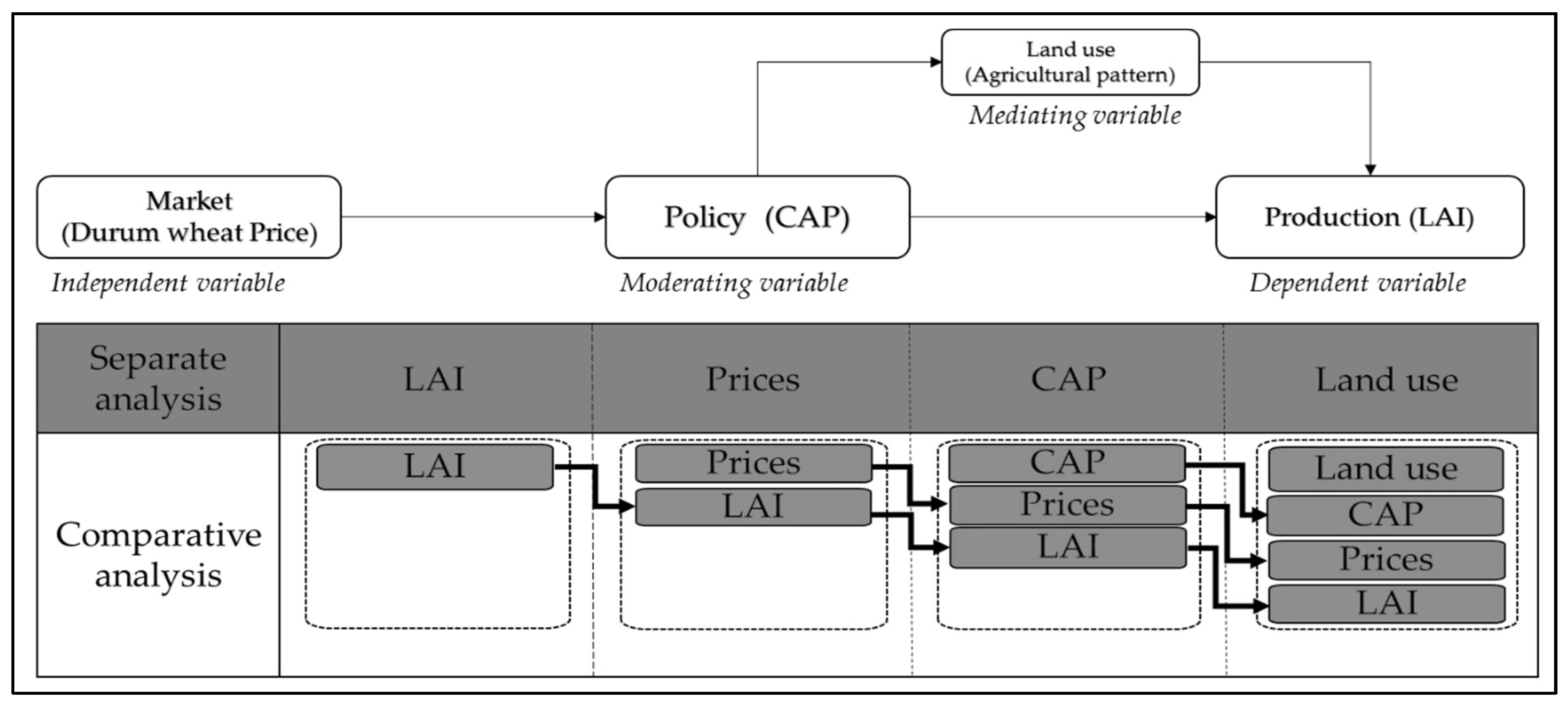
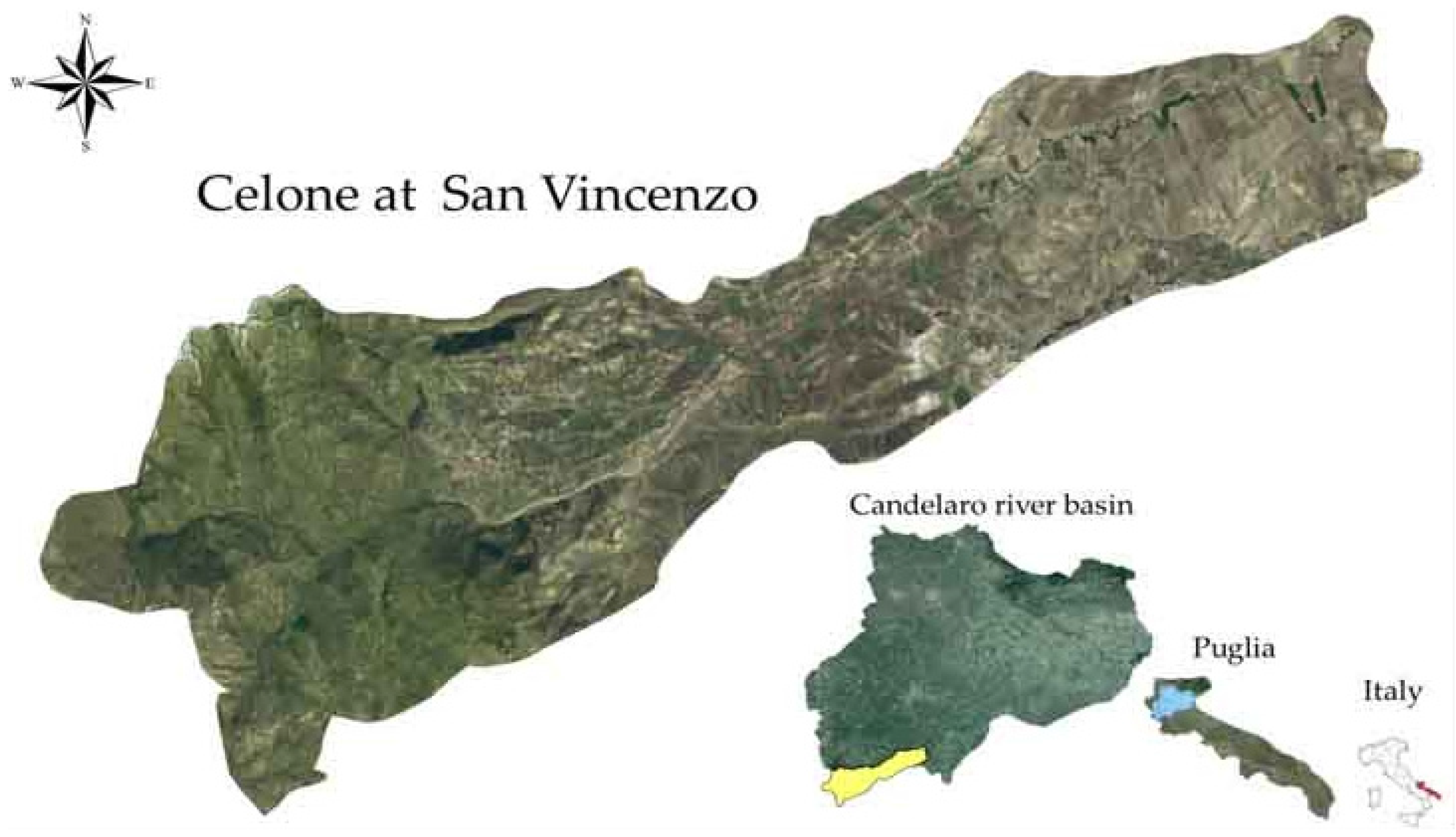
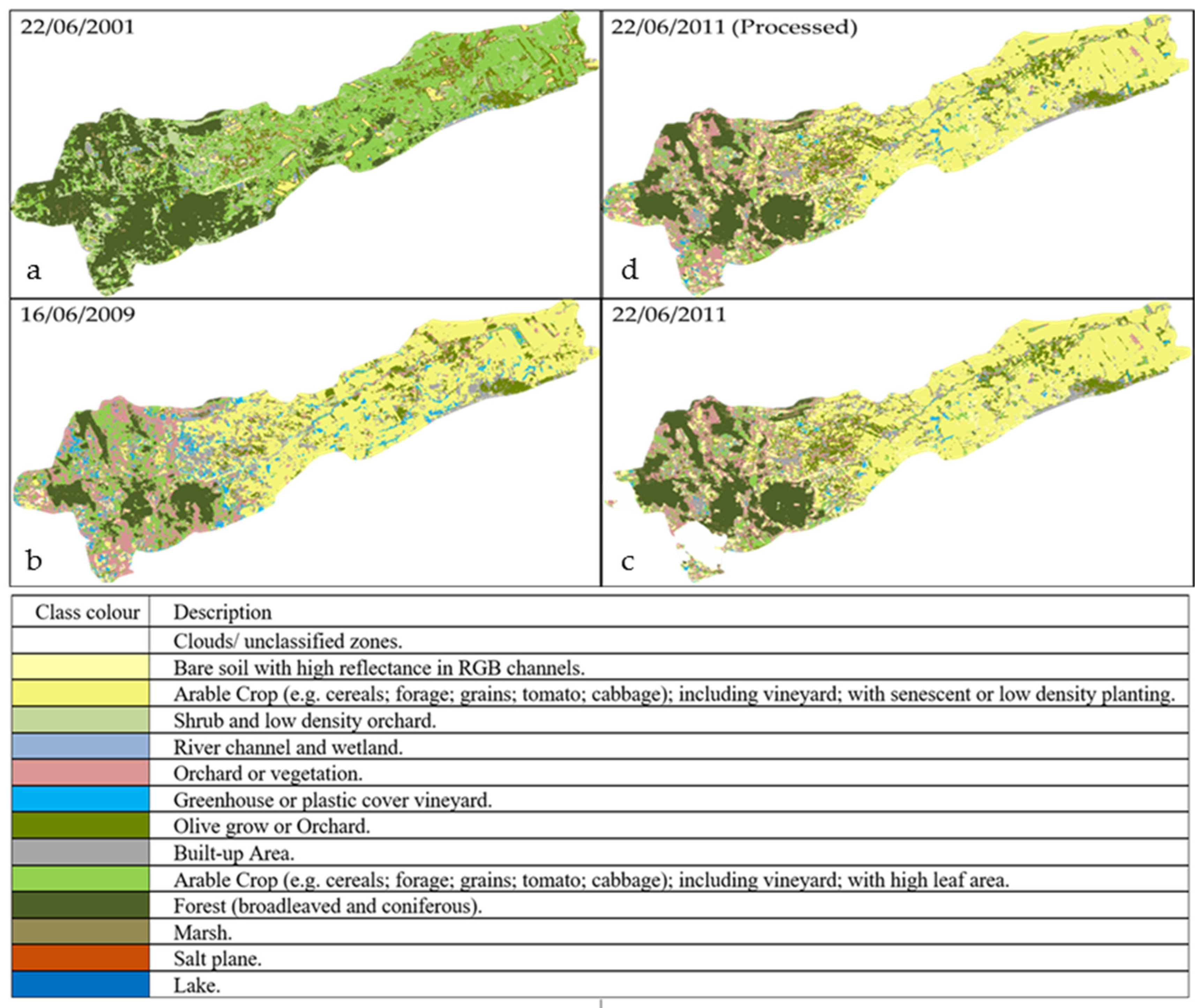
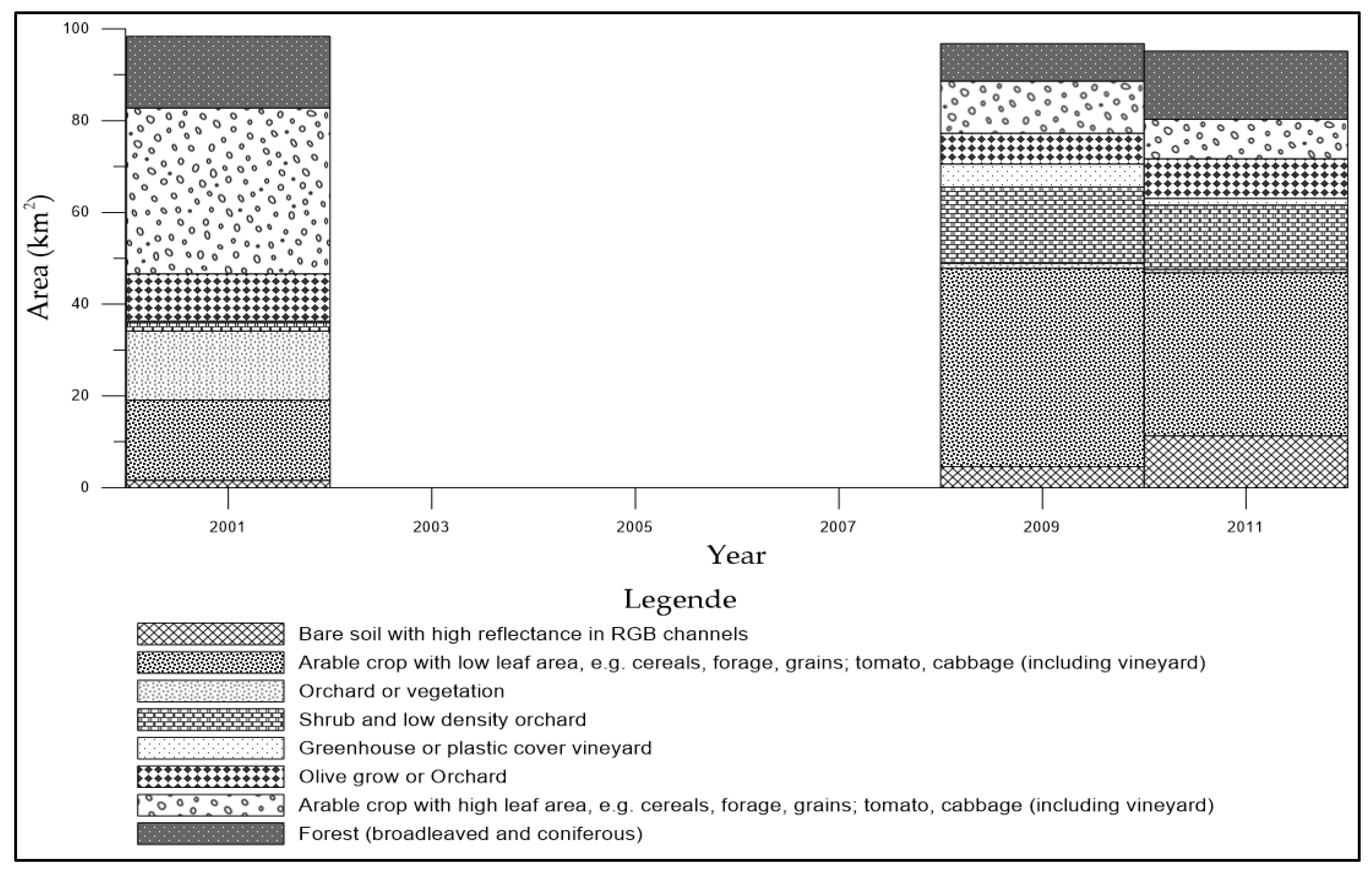
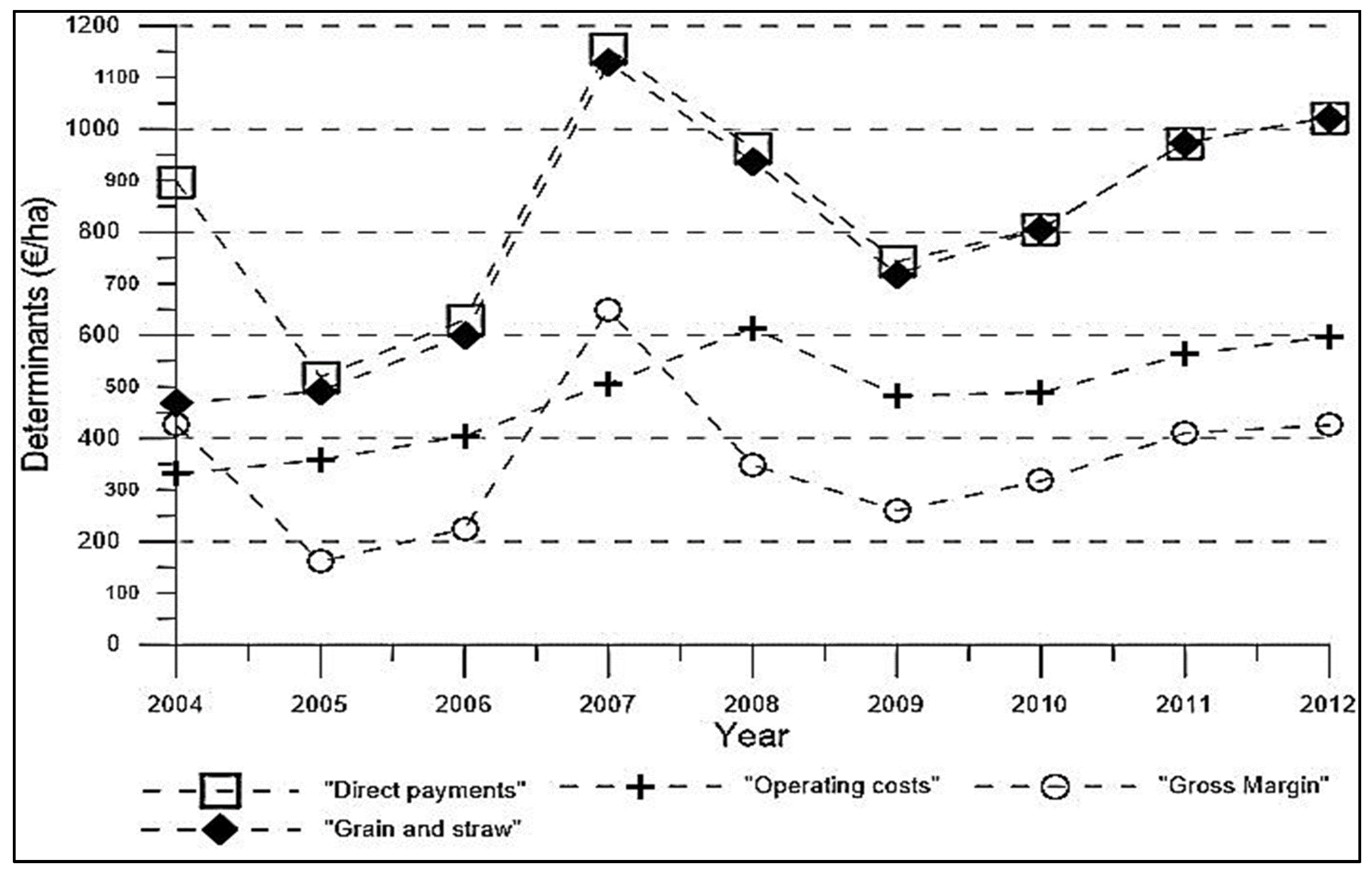
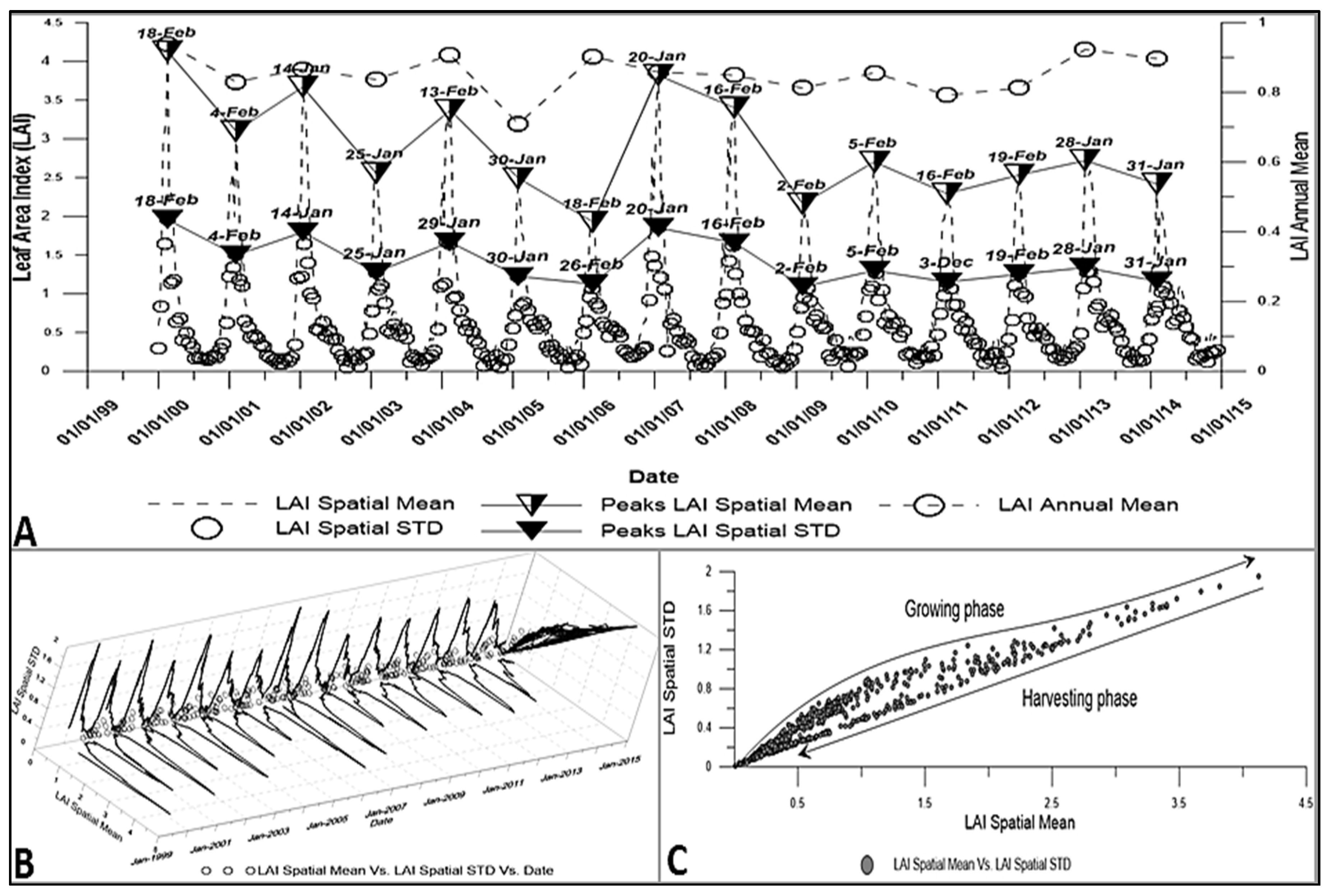
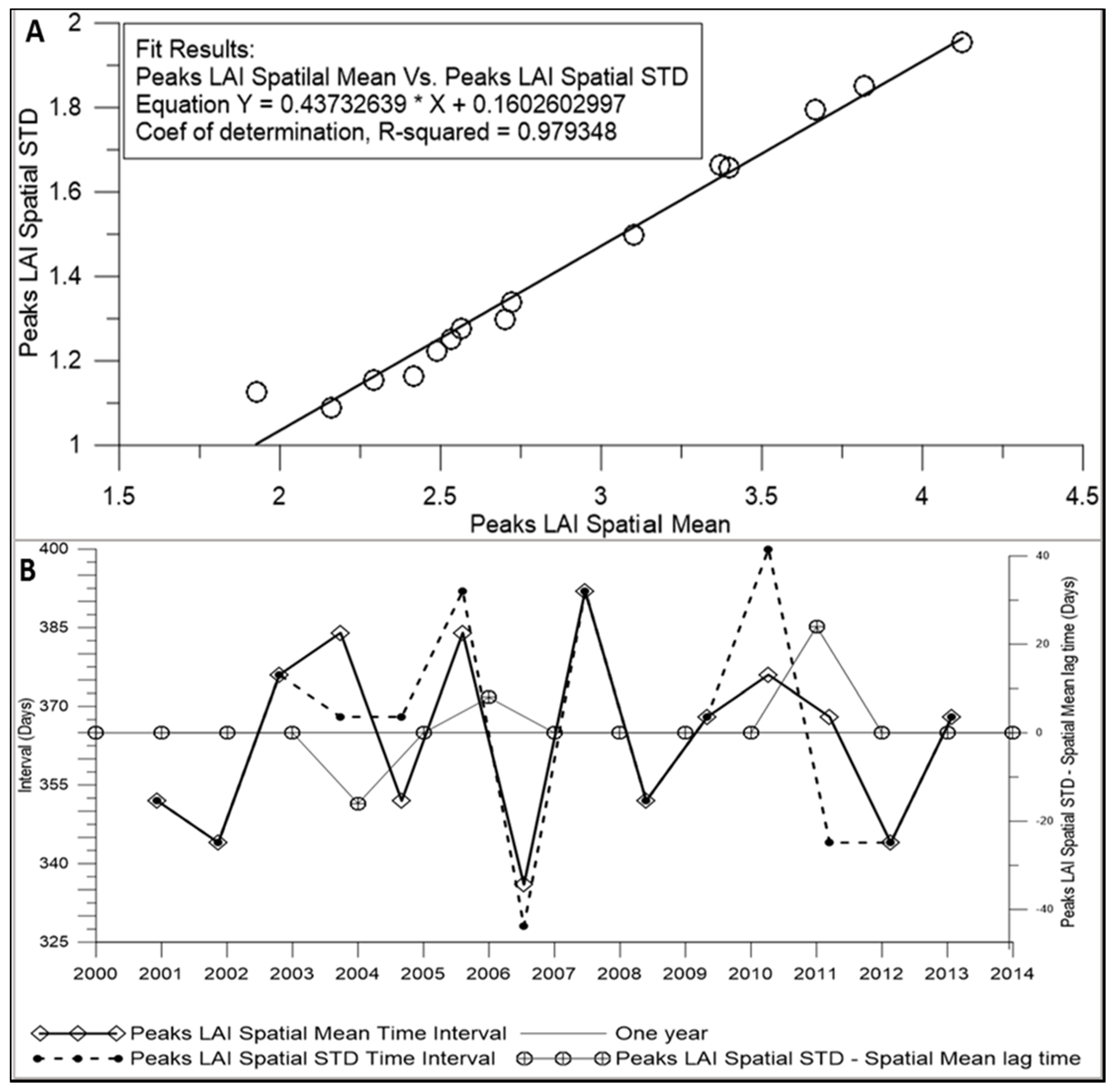


| Date of Acquisition | WRS Path/Row | Sensor |
|---|---|---|
| 22/06/2011 | 189/031 | TM |
| 16/06/2009 | 189/031 | TM |
| 22/06/2011 | 189/031 | ETM+ |
| Type | Unit | 2004 | 2005 | 2006 | 2007 | 2008 | 2009 | 2010 | 2011 | 2012 | Average |
|---|---|---|---|---|---|---|---|---|---|---|---|
| Representativeness of the sample | |||||||||||
| Sample farms | number | 680 | 465 | 420 | 515 | 400 | 520 | 585 | 540 | - | 515.6 |
| Farms represented | number | 48,400 | 39,900 | 35,700 | 45,700 | 48,500 | 50,000 | 54,700 | 49,000 | - | 46,487.5 |
| Structural information (average per farm) | |||||||||||
| Total Utilized Agricultural Area | ha | 24.1 | 25.0 | 24.3 | 22.5 | 22.1 | 23.3 | 23.5 | 23.4 | - | 23.5 |
| Total labor input | AWU | 0.8 | 0.8 | 0.8 | 0.8 | 0.8 | 0.8 | 0.8 | 0.9 | - | 0.8 |
| Durum wheat area | ha | 19.1 | 18.4 | 17.0 | 16.6 | 16.4 | 14.8 | 14.8 | 14.5 | 14.5 | 16.5 |
| Irrigated area | ha | 0.3 | 0.4 | 0.3 | 0.2 | 0.5 | 0.4 | 0.3 | 0.3 | - | 0.3 |
| Durum wheat production | t | 61 | 58 | 56 | 54 | 57 | 51 | 51 | 51 | 53 | 55.0 |
| Durum wheat yield | t/ha | 3.2 | 3.2 | 3.3 | 3.3 | 3.5 | 3.5 | 3.5 | 3.5 | 3.7 | 3.4 |
| Durum wheat price | €/t | 138 | 148 | 174 | 336 | 263 | 197 | 221 | 270 | 270 | 218.4 |
| Durum wheat output | k € | 8.4 | 8.6 | 9.7 | 18.3 | 15.1 | 10.1 | 11.4 | 13.7 | 14.4 | 11.9 |
| Durum wheat production operating costs (average per farm) | |||||||||||
| Specific costs | €/ha | 164 | 166 | 183 | 223 | 303 | 239 | 223 | 244 | 258 | 222.6 |
| Seeds | €/ha | 66 | 67 | 65 | 85 | 111 | 87 | 76 | 78 | 82 | 79.6 |
| Fertilizers | €/ha | 62 | 62 | 73 | 91 | 135 | 107 | 101 | 119 | 126 | 97.3 |
| Crop protection | €/ha | 32 | 33 | 38 | 41 | 45 | 37 | 38 | 41 | 42 | 38.7 |
| Water | €/ha | 0 | 0 | 1 | 0 | - | 1 | 1 | 0 | 0 | 0.5 |
| Other specific costs | €/ha | 4 | 4 | 5 | 5 | 13 | 7 | 6 | 7 | 7 | 6.4 |
| Non-specific costs | €/ha | 167 | 192 | 222 | 284 | 311 | 244 | 267 | 318 | 340 | 260.5 |
| fuels and lubricants | €/ha | 56 | 75 | 78 | 112 | 106 | 90 | 92 | 123 | 137 | 96.7 |
| machines & buildings upkeep | €/ha | 26 | 30 | 32 | 45 | 30 | 16 | 28 | 35 | 36 | 31.1 |
| Contract work | €/ha | 50 | 46 | 60 | 68 | 71 | 62 | 67 | 82 | 85 | 65.7 |
| Energy | €/ha | 0 | 0 | 0 | 0 | 12 | 7 | 10 | 11 | 12 | 5.8 |
| Other direct costs | €/ha | 34 | 40 | 51 | 58 | 93 | 70 | 69 | 67 | 69 | 61.3 |
| Total Operating costs | €/ha | 331 | 359 | 405 | 507 | 614 | 483 | 489 | 563 | 597 | 483.1 |
| Operating costs per ton of grain | €/t | 104 | 113 | 123 | 155 | 176 | 140 | 141 | 161 | 163 | 141.8 |
| Year | 2001 | 2009 | 2011 | |||
|---|---|---|---|---|---|---|
| Land Use | Area (km2) | % | Area (km2) | % | Area (km2) | % |
| Agricultural and forest area | 98.345 | 97 | 96.812 | 95 | 95.182 | 94 |
| River channel and wetland | 0.164 | 0 | 0.316 | 0 | 0.703 | 1 |
| Built-up area | 2.907 | 3 | 3.380 | 3 | 4.322 | 4 |
| Marsh | 0.321 | 0 | 1.148 | 1 | 1.473 | 1 |
| Salt plan | 0.021 | 0 | 0.102 | 0 | 0.002 | 0 |
| Lake | 0.000 | 0 | 0.000 | 0 | 0.076 | 0 |
| Year | 2001 | 2009 | 2011 | |||
|---|---|---|---|---|---|---|
| Land Use | Area (km2) | % | Area (km2) | % | Area (km2) | % |
| Bare soil with high reflectance in RGB channels | 1.616 | 2 | 04.579 | 5 | 11.295 | 12 |
| Arable crops with low leaf area index | 17.499 | 18 | 43.218 | 45 | 35.565 | 37 |
| Shrub and low density orchard | 15.061 | 15 | 01.130 | 1 | 00.732 | 1 |
| Orchard or vegetation | 01.801 | 2 | 16.568 | 17 | 14.010 | 15 |
| Greenhouse or plastic cover vineyard | 00.360 | 0 | 05.720 | 5 | 01.433 | 2 |
| Olive grow or orchard | 10.280 | 10 | 06.690 | 7 | 08.646 | 9 |
| Arable crops with high leaf area index | 36.136 | 37 | 11.366 | 12 | 08.588 | 9 |
| Forests (broadleaved and coniferous) | 15.592 | 16 | 08.189 | 8 | 14.913 | 16 |
© 2017 by the authors. Licensee MDPI, Basel, Switzerland. This article is an open access article distributed under the terms and conditions of the Creative Commons Attribution (CC BY) license ( http://creativecommons.org/licenses/by/4.0/).
Share and Cite
Siad, S.M.; Gioia, A.; Hoogenboom, G.; Iacobellis, V.; Novelli, A.; Tarantino, E.; Zdruli, P. Durum Wheat Cover Analysis in the Scope of Policy and Market Price Changes: A Case Study in Southern Italy. Agriculture 2017, 7, 12. https://doi.org/10.3390/agriculture7020012
Siad SM, Gioia A, Hoogenboom G, Iacobellis V, Novelli A, Tarantino E, Zdruli P. Durum Wheat Cover Analysis in the Scope of Policy and Market Price Changes: A Case Study in Southern Italy. Agriculture. 2017; 7(2):12. https://doi.org/10.3390/agriculture7020012
Chicago/Turabian StyleSiad, Si Mokrane, Andrea Gioia, Gerrit Hoogenboom, Vito Iacobellis, Antonio Novelli, Eufemia Tarantino, and Pandi Zdruli. 2017. "Durum Wheat Cover Analysis in the Scope of Policy and Market Price Changes: A Case Study in Southern Italy" Agriculture 7, no. 2: 12. https://doi.org/10.3390/agriculture7020012
APA StyleSiad, S. M., Gioia, A., Hoogenboom, G., Iacobellis, V., Novelli, A., Tarantino, E., & Zdruli, P. (2017). Durum Wheat Cover Analysis in the Scope of Policy and Market Price Changes: A Case Study in Southern Italy. Agriculture, 7(2), 12. https://doi.org/10.3390/agriculture7020012









